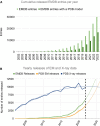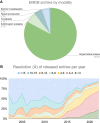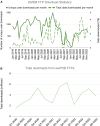EMDB-the Electron Microscopy Data Bank
- PMID: 37994703
- PMCID: PMC10767987
- DOI: 10.1093/nar/gkad1019
EMDB-the Electron Microscopy Data Bank
Erratum in
-
Correction to 'EMDB-the Electron Microscopy Data Bank'.Nucleic Acids Res. 2024 Jan 5;52(D1):D1701. doi: 10.1093/nar/gkad1199. Nucleic Acids Res. 2024. PMID: 38059399 Free PMC article. No abstract available.
Abstract
The Electron Microscopy Data Bank (EMDB) is the global public archive of three-dimensional electron microscopy (3DEM) maps of biological specimens derived from transmission electron microscopy experiments. As of 2021, EMDB is managed by the Worldwide Protein Data Bank consortium (wwPDB; wwpdb.org) as a wwPDB Core Archive, and the EMDB team is a core member of the consortium. Today, EMDB houses over 30 000 entries with maps containing macromolecules, complexes, viruses, organelles and cells. Herein, we provide an overview of the rapidly growing EMDB archive, including its current holdings, recent updates, and future plans.
© The Author(s) 2023. Published by Oxford University Press on behalf of Nucleic Acids Research.
Figures





References
-
- Kühlbrandt W. The resolution revolution. Science. 2014; 343:1443–1444. - PubMed
Publication types
MeSH terms
Substances
Grants and funding
LinkOut - more resources
Full Text Sources
Molecular Biology Databases
Research Materials

